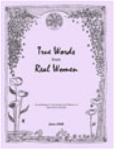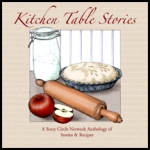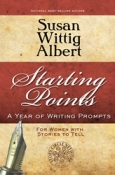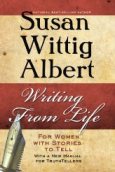
by Story Circle Founder and President, Susan Wittig Albert
Biographical fiction, which toes a delicate line between acknowledged fact and imagined truth, creates its own special research and writing demands. And sometimes, extraordinary challenges.
For Loving Eleanor—the story of Lorena Hickok’s friendship with Eleanor Roosevelt —I started in the usual place: by reading everything I could find about Lorena (Hick, she was called). As it turned out, there wasn’t much readily accessible material, except for brief introductions to her Depression-era investigative reports to Harry Hopkins, a woefully inadequate biography published in 1980 by Doris Faber, and Rodger Streitmatter’s notes in Empty Without You, his collection of letters written by Hick and Eleanor. I had a lot of digging to do.
Hick was a woman who went through life with her elbows out. She began working as a journalist at the Battle Creek Journal in 1913 when she was just 19. She had a gift for telling a taut, well-honed story, and her abilities were quickly recognized. Two years later, she moved to the Milwaukee Sentinel, briefly to the New York Tribune, then (in 1918), to the Minneapolis Tribune, where she earned her stripes as a reporter, feature writer, and Sunday editor. In an unusual move, her editor, Tom Dillon, assigned her to the sports desk. Her breezy, conversational style was new to sports journalism, and as a female sportswriter, her work was groundbreaking.
In 1927, at the end of a failed love affair, Hick went back to New York, first to the tabloid Mirror and then to the Associated Press. She was the first woman to be hired in the flagship New York bureau. Fearless and energetic, she quickly earned a by-line. In her first year at the AP, she covered the sinking of the steamship Vestris, which gave her another first: she was the first woman to have a bylined front page story in the New York Times. As an investigative reporter, she covered politics (FDR’s election as New York governor in 1928); political corruption (the downfall of New York mayor Jimmy Walker and the hugely complicated trial of banker Charles E. Mitchell); and sensational crime (the Lindbergh baby kidnapping). I’ve found her bylined stories in hundreds of newspapers across the country, and almost every story is a standout.
In 1933, at the top of her game, Hick left the AP. It was an anguished decision she felt she was forced to make. Her deepening personal (and very intimate) friendship with the new First Lady made it impossible for her to write objectively about the Roosevelt administration. She believed that she was ethically compromised, and she did the honest–but very painful–thing. She went to work for Harry Hopkins, the director of the Federal Emergency Relief Administration. For the next two years, she traveled across the country, investigating government-sponsored relief programs and reporting on Depression-era conditions in 32 states. Her nearly 80 confidential FERA reports, written in bleak hotel rooms late at night, provide us with vivid, no-holds-barred descriptions of the appalling—and yet heroic—plight of millions of destitute Americans. She felt their anguish. Even now, reading her reports, we can feel it, too.
When Hick left FERA in 1936, it was the end of her work as an investigative journalist–but not the end of her writing career. In another post, we’ll take a look at her 15-year career as a biographer.
Lorena Hickok, Biographer
This is Part 2 of a two-part series of posts about Lorena Hickok, the journalist whose friendship helped to put Eleanor Roosevelt into the media spotlight–and the central character in my novel, Loving Eleanor. Part 1 is about Hick’s work as a journalist. But she didn’t just write newspaper stories. After she retired from political life in 1945, she wrote biographies. This post is a quick sketch of that part of her writing career.
In 1952, at the suggestion of Eleanor’s literary agent, Nannine Joseph, Hick undertook the writing of profiles of women in political life–the first book of its kind. Called Ladies of Courage, it was an inspiring account of women’s struggle for recognition in American public and political life in the thirty-five years since women had gained the vote. ER lent the luster of her name to the book and Tommy typed the manuscript, but Hick spent the better part of two years on the research—including extensive interviews with her subjects—and the writing. Before she submitted the finished manuscript, she shared it with ER, who wrote: At last tonight I’ve finished reading your material [for Ladies of Courage] and it is simply swell I think. Much more interesting than I thought it could possibly be made.
The book, which included profiles of Frances Perkins, Clare Boothe Luce, Helen Gahagan Douglas, and Oveta Culp Hobby, was published in 1954. Thanks to ER’s name recognition, it received extensive newspaper attention. Hick traveled around the country, speaking to women’s groups about the book and about the challenges women faced in political life. In recognition of her authorship, ER assigned her the royalties, which cumulatively amounted to about $4,000 (about $35,000 in 2015).
As a journalist, Hick had always been deeply interested in people who had stories, who met extraordinary challenges. In the profiles of the Ladies of Courage, Hick had found a narrative voice that enabled her to tell these stories. After that book was published, she began work on what would be three biographies for young readers in Grosset & Dunlap’s much-heralded Signature Books series: The Story of Franklin D. Roosevelt (1956), The Story of Helen Keller (1958), and The Story of Eleanor Roosevelt (1959). For Scholastic, Hick also wrote a biography of FDR, this one focusing on his early political life: The Road to the White House: FDR, The Pre-Presidential Years (1962).
Of the four books for young readers, Hick’s biography of Helen Keller was the most successful. It was adopted by several school-affiliated book clubs, and sales were boosted even further by the 1957 teleplay by William Gibson, The Miracle Worker, followed by the Broadway play and the 1962 film of the starring Patty Duke. The royalties would help to support Hick for the rest of her life.
When Hick was doing the research for the Keller biography, she became deeply interested in Keller’s teacher, and went on to write a biography for older teens called The Touch of Magic: The Story of Helen Keller’s Great Teacher, Anne Sullivan Macy. The book was published by Dodd, Mead in 1961. Hick felt a special admiration for Macy, who had given Helen Keller her voice. “No author ever finished a book with greater regret,” she wrote in her foreword. “During the months I worked on this book she became as real to me as a living person . . . I miss her.” I can’t help wondering if Hick saw something of herself in Anne Sullivan Macy. Perhaps Hick thought that the empowering help she gave Eleanor—encouraging her to do the press conferences, supporting her early efforts as a writer, urging her to write her newspaper column—was something like the help that Teacher (Helen Keller’s name for Macy) provided her student. Teacher gave Helen her voice and helped to create a place for her in the world. It’s no exaggeration to say that Hick gave Eleanorher voice, as well.
While Hick was working on the Macy biography, she struck up a professional friendship with Allen Klots, her editor at Dodd, Mead. When The Touch of Magic was finished, Hick proposed to Klots the project that became Eleanor Roosevelt: Reluctant First Lady, the book for which Hick is probably best known. It sketches out their most intense friendship without, of course, giving clues to its intimacy. Finished in 1961, Reluctant First Lady was published just prior to ER’s death. it sold well and the royalties from that and her other projects provided Hick with something approaching a comfortable living.
Throughout her adult life, Hick was severely diabetic, and the disease began to curtail her professional activities in the late 1930s. When she finished Reluctant First Lady, she began a biography of labor leader Walter Reuther (also for Dodd, Mead), but her failing eyesight compelled her to stop not long before her death in 1968. That project was completed by Jean Gould and published under the title Walter Reuther: Labor’s Rugged Individualist—with Hick’s name on the cover, as well as Gould’s. That book brought to eight the number of biographies Hick produced in the last fifteen years of her life.
And speaking of biographies: a new dual biography of Hick and Eleanor, by Susan Quinn, will be out in September. I haven’t seen it yet, but I’m anxious to read it. I hope Quinn will pay attention to Hick as a writer, as well as the woman who helped to give Eleanor Roosevelt her voice. Hick’s first biographer, Doris Faber, failed her. She deserves a biographer who understands and pays attention to her professional work, as well as her empowering friendship with Eleanor Roosevelt.
Want to read more about Susan’s journey in writing Loving Eleanor? Check out The Secret Story Behind Loving Eleanor.

Susan Wittig Albert is a best-selling novelist, memoirist, and author of both adult and young adult fiction and nonfiction. She lives on a 31-acre Texas Hill Country homestead with her husband and frequent coauthor, Bill Albert. She founded The Story Circle Network in 1997. Her website:www.susanalbert.com


 B. Lynn Goodwin is the owner of Writer Advice,
B. Lynn Goodwin is the owner of Writer Advice,





